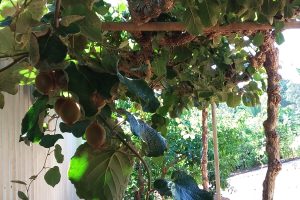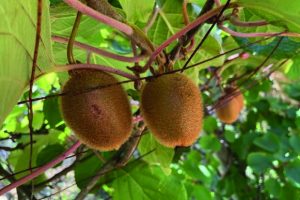Actinidia chinensis var. deliciosa
Kiwifruit, Chinese gooseberry
Origin
Native to southern China.
Climate
Kiwifruit is particularly susceptible to cold. Although deciduous, plants can freeze, and to minimise this risk in low-lying or frost-prone areas, trunks should be lagged in winter. Young shoots in spring are very frost tender, and late spring frosts are a major hazard. Premature frosts in autumn or early winter threaten unharvested fruit.
Plant Description
A vigorous, woody, twining vine or climbing shrub reaching 9m. Its leaves are alternate, long-petioled, deciduous, oval to nearly circular, cordate at the base, and 7.5–12.5 cm long. Young leaves are coated with red hairs; mature leaves are dark green and hairless on the upper surface, and downy-white with prominent, light-colored veins beneath. The kiwifruit is a very long-lived plant- up to 80 years or more.
Relatives
Actinidiaceae Family. There are perhaps 60 species of kiwifruit throughout China and into Japan and Siberia, and now transported to many parts of the world. Many grow at altitudes up to 2,000m.
Soils
Soils must be well-drained: plants cannot stand wet feet, requiring a minimum winter water table of 1m to produce well. Plants need a lot of moisture in the growing season and they thrive best where rainfall is well distributed and humidity relatively high. An annual precipitation or irrigation of 1250-2500mm is needed.
Propogation
Grafting or budding is preferred in order to guarantee the gender and suitability of the males with the females.
Cultivars
Hayward is the most common female kiwi grown. Also Bruno, Abbott and Monty. There are many other cultivars, many of them bud sports of Hayward. There is also a range of male cultivars which are selected for the span of time they provide pollen. Matua, McLean and Moonya are some male cultivars.
Flowering and Pollination
The flowers are fragrant, dioecious, borne singly or in threes in the leaf axils, have five or six petals, white at first, fading to yellow. Both sexes have central tufts of many stamens, though those of the female flowers have no viable pollen. The flowers also lack nectar, hence honey bees are not attracted. They may crawl around on the flowers and accidentally pollinate them, but results are not outstanding. Hand pollination is sometimes employed: Male flowers are gathered and the pollen extracted and sprayed or brushed on the female flowers. Male plants are planted in the ratio of 1 male to 8 females in larger orchards.
Cultivation
Take care when planting; avoid disturbing the roots. Kiwis need a large, substantial, well-stayed trellis. There are several styles, including T-bar and pergola, at least 1.8m high. Young vines need to be correctly trained, with one straight trunk and one leader on each side. Fruiting laterals are produced on the fruiting arms and these are replaced every 1, 2 or 3 years.
Wind Tolerance
Adequate shelter belts are important: without them plants do not establish well, and many of the new flowering shoots blow off in spring, greatly reducing the crop. If strong winds partially or totally defoliate vines in summer or early autumn, cropping capacity for the next season is greatly reduced – fruit initiation within the buds does not occur until late in the season. Wind rub of fruit close to harvest can also reduce the quality of the fruit.
Pruning
Pruning is one of the most important aspects of vine management, and plays a major part in obtaining consistently good yields each season. Successful management needs good open pruning to prevent the vines becoming dense and tangled.
This allows:
- access for bees during flowering
- penetration of sprays
- air movement around the vines
- light penetration through the vines to minimise conditions favourable to fungal diseases (e.g. Botrytis)
- adequate light to ripen fruit and mature the fruiting canes for the following season.
It is only under conditions of reasonable light penetration that new shoots will originate from points on, or close to the main leader. Kiwifruit crop on current season’s growth that originates from 1-year-old wood. Usually only the six bottom buds on a fruiting shoot produce fruit. The aim of winter pruning, which is done in the dormant season, is to leave the optimum amount of 1-year-old wood on the vine. This growth should be evenly distributed, and well spaced out. There should be only one distinct layer of shoots. Each fruiting arm should originate near the centre wire, with 25-35cm between each, allowing good exposure to sunlight. Each vine must be restricted to its allotted space, and not allowed to tangle with its neighbours along the row, or across the row in a pergola system. Male vines are much more vigorous than the females. The major pruning of males is given immediately after flowering when the flowering arms are cut back to new growth originating close to the leader.
The Fruit
The fruits are oblong and up to 6cm long. The green-brown skin of the fruits is covered with short, stiff, brown hairs. The flesh is firm until fully ripened, when it softens. The colour of the flesh is bright-green, or sometimes yellow, paler in the centre with many fine, radiating, pale lines. Breeders have also developed fruits with red colouring inside. The flavor is subacid to quite acid.
Fruit Production and Harvesting
The fruit is harvested when 6.25% T.S.S is attained.
Fruit Uses
Eaten fresh, and used for decoration of various desserts and salads. Also made into jams, preserves and liqueurs. They dry very well.
Pests and Diseases
Bacterial disease.
Comments
Kiwifruit will grow and fruit in the Perth region provided consideration is given to the chilling requirement, they get sufficient water and are pruned properly.

